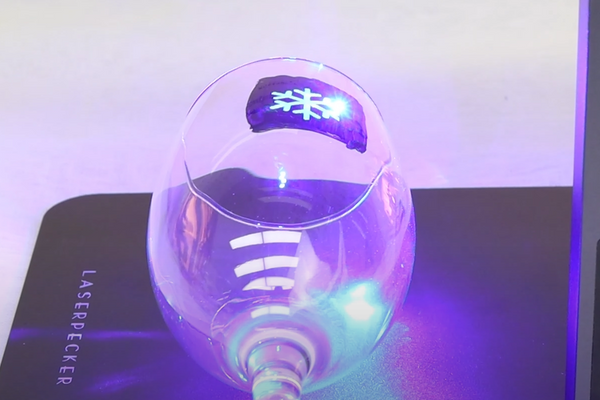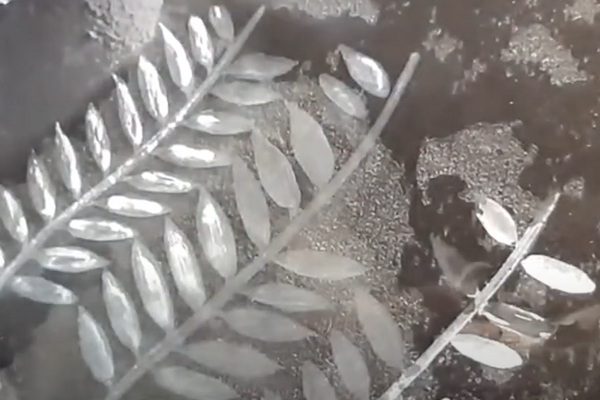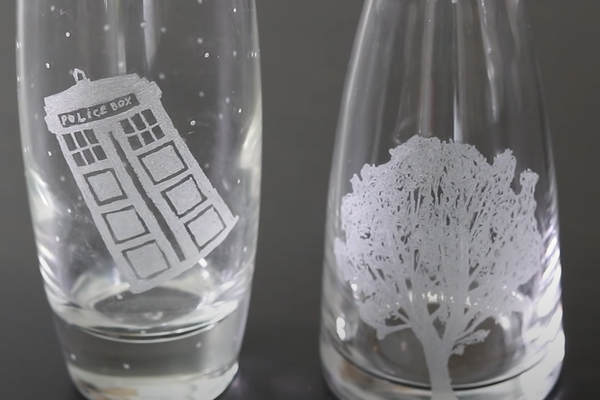Engraved glass is a great way to personalize gifts. Whether it's a custom wine glass set, a beer mug with the recipient's name and a meaningful emblem, or any personalized detail, it shows the effort you put into the gift.
Imagine drinking from an engraved glass with a custom design of your choice and enjoying relaxing moments alone or with friends. In this blog, we'll introduce you to the top 5 methods for engraving on glass , explaining the tools required and the individual steps for each method.

In this article:
Method 1: How does the laser engrave glass
Laser engraving on glass is a highly precise method for etching designs, patterns, text, or images onto glass surfaces using a focused laser beam. This versatile technique is used for creating personalized gifts, decorative items, signage, and more, as it enables intricate and detailed results on glass objects.
Tools required for laser engraving on glass
Glass laser engraving machine: A portable yet powerful laser engraving machine like the LaserPecker 4 that is specifically designed for glass processing.
Design software: Create or import designs into the LaserPecker engraving machine software to customize them.
Personal protective equipment (PPE): Wear safety goggles and a laser safety hood to ensure safety when working with the laser.
Masking materials: Adhesive tape or special masking products to protect certain areas of the glass during engraving.
Cleaning materials: Isopropyl alcohol, microfiber cloths, and other post-engraving cleaning agents.
How does the laser engrave glass
Step 1 - Design creation or import: Create the desired design using CAD software or import existing designs into the engraving machine software.
Step 2 - Preparing the Glass Thoroughly clean the glass surface to ensure there are no particles or residues that could interfere with the engraving process. Apply masking material to protect the areas that will not be engraved.
Step 3 - Setting up the engraving machine: Configure the laser engraving machine with the appropriate settings, including laser power, speed, frequency and focus, depending on the design and type of glass used.
Step 4 - Engraving on Glass: Start the engraving process and ensure the machine precisely follows the specified design to etch it onto the glass surface. Monitor the process to ensure precision and quality.

Step 5 - Post-Engraving Cleaning: Once engraving is complete, remove the cover material and thoroughly clean the glass with isopropyl alcohol or a similar cleaner to remove any residue or particles left over from the engraving process.
Step 6 - Finishing (optional): If desired, apply surface treatments or coatings to improve the appearance or durability of the engraved design.
Video tutorial for laser engraving on glass
Method 2: How to engrave glass by hand (carving)
Hand engraving or carving on glass involves etching designs, patterns, or text onto glass surfaces using manual tools. This traditional method allows for artistic freedom and individual detail, creating unique and intricate designs on glassware, ornaments, and decorative objects.
Diamond burs: Small, specialized tools with diamond-coated tips used for carving and engraving on glass. They come in various shapes and sizes for different engraving effects.
Vise or rotary tool: Handheld devices used to hold and maneuver diamond cutters for precise engraving on glass surfaces.
Covering materials: Adhesive tape or protective film for covering areas on the glass not intended for engraving to protect them from accidental scratching.
Cleaning materials: Isopropyl alcohol, microfiber cloths, or glass cleaner to clean the glass before and after engraving.
Personal protective equipment (PPE): Safety glasses and gloves for protection against glass particles and general safety at work.

How to engrave glass by hand
Step 1 - Design Preparation: Decide on the design you want engraved on the glass and sketch it out on paper. This will help you visualize the design before you begin the engraving process.
Step 2 - Prepare the glass: Thoroughly clean the glass surface to remove any dirt, oil, or residue. Apply masking material to protect the areas not intended for engraving.
Step 3 - Selecting the diamond cutter and tool: Select the appropriate diamond cutter for the desired engraving effect and insert it into the vise or rotary tool.
Step 4 - Engrave the glass: Using the selected tool and diamond cutter, carefully and evenly scratch the design onto the glass surface. Control the pressure applied to achieve varying depths and intricacies in the engraving.
Step 5 - Clean the engraved glass: After the engraving is complete, remove the cover material and clean the glass surface to remove any residue and particles created during the engraving process.
Step 6 - Finishing (optional): Optionally, you can apply a protective coating or finishing touch to the engraved area to improve the visibility or durability of the design.
Video tutorial for hand engraving on glass
Method 3: How to engrave glass with a Dremel
When engraving glass with a Dremel, designs, patterns, or text are etched onto glass surfaces using a rotating tool. A versatile handheld tool with various attachments, the Dremel allows for precision and control when creating custom and intricate engravings on glassware, mirrors, and decorative items.
Tools required for glass engraving with a Dremel
Dremel Rotary Tool: A fast, handheld rotary tool with engraving attachments suitable for glass engraving.
Diamond cutters or engraving tips: Special attachments with diamond-coated tips for engraving on glass surfaces.
Covering materials: Adhesive tape or protective film for covering areas on the glass not intended for engraving to protect them from accidental scratching.
Cleaning materials: Isopropyl alcohol, microfiber cloths, or glass cleaner to clean the glass before and after engraving.
Personal protective equipment (PPE): Safety glasses and gloves to protect against glass particles and ensure safety when working with the Dremel.

How to engrave glass with a Dremel
Step 1 - Design Preparation: Determine the design or pattern to be engraved on the glass surface. Create a sketch or stencil to guide the engraving process.
Step 2 - Prepare the glass: Thoroughly clean the glass surface to remove any dirt, oil, or residue. Apply masking material to protect the areas not intended for engraving.
Step 3 - Selecting the diamond cutter and engraving tips: Select the appropriate engraving attachment and securely attach it to the Dremel rotary tool.
Step 4 - Engrave the glass: Use the Dremel tool with the selected engraving bit to carefully and methodically etch the chosen design into the glass surface. Control the speed of the tool and the applied pressure to achieve optimal control and precision in creating the desired depth and complexity of the engraving.
Step 5 - Clean the engraved glass: After the engraving process is complete, remove the masking material and thoroughly clean the glass surface. This step ensures that any residue or particles left over from the etching process are removed.
Step 6 - Finishing touches (optional): As a final step, you can apply a protective coating to the engraved area to improve both the visibility and durability of the design.
Video tutorial for engraving on glass with a Dremel
Method 4: How to engrave glass with the Cricut Maker to create items such as vases, mirrors or glassware.
When engraving glass with a Cricut Maker, a special tool called an engraving tip is used with the Cricut machine to engrave designs, patterns, or text onto glass surfaces. This method offers precision and individuality, allowing the user to create intricate and personalized engravings on various glass items.
Tools required for glass engraving with the Cricut Maker
Cricut Maker: A cutting machine that supports the use of the engraving tip and is compatible with Design Space software.
Engraving Tip: A special tool designed for use with the Cricut Maker to engrave designs on materials such as glass.
Masking materials: Adhesive tape or film used to cover areas on the glass surface not intended for engraving to protect them from the etching process.
Cleaning materials: Isopropyl alcohol, microfiber cloths, or glass cleaner to clean the glass before and after engraving.
Personal protective equipment (PPE): Safety goggles to protect the eyes during the engraving process.

How to engrave glass with Cricut Maker
Step 1 - Design Preparation: Create or select the design or pattern you want to engrave using the Cricut Design Space software. Make sure the design is compatible with the engraving tip and is the correct size for the glass object.
Step 2 - Prepare the glass: Thoroughly clean the glass surface to remove any dust, fingerprints, or residue that could interfere with the engraving. Cover any areas not intended for engraving with masking material.
Step 3 - Set up your Cricut Maker: Insert the engraving tip into your Cricut Maker and load your chosen design into the Design Space software by following the included instructions.
Step 4 – Adjust Settings: In the Design Space software, adjust the settings for the material (glass) and engraving tip. Ensure the correct settings for depth, pressure, and speed are selected for optimal engraving results.
Step 5 - Engrave the glass: Place the prepared glass object on the Cricut Maker cutting mat and securely attach it. Start the engraving process so the machine can precisely etch the design onto the glass surface.
Step 6 - Clean the engraved glass: After the engraving is complete, carefully remove the cover material and thoroughly clean the glass surface to remove any engraving residue.
Video tutorial for engraving on glass with the Cricut Maker
Method 5: How to engrave glass by sandblasting
Sandblasting is a technique that uses high-speed blasting media to engrave or etch designs into glass surfaces. This method can create precise and intricate details, creating matte or textured designs on glassware, windows, mirrors, and other glass objects.
Tools required for glass engraving by sandblasting
Sandblaster: Device that projects blasting media such as sand, aluminum oxide, or silicon carbide at high pressure onto the glass surface.
Abrasive material: Fine-grained materials used for sandblasting, such as sand or other blasting media suitable for etching glass.
Stencil or masking material: Stencils or masking materials (vinyl, self-adhesive film or special stencils) used to cover areas on the glass not intended for etching in order to protect them from the abrasive particles.
Air compressor: Provides the required air pressure to propel the blasting media through the sandblaster onto the glass surface.
Personal protective equipment (PPE): Safety goggles, gloves, and a respirator to protect against abrasive particles and ensure safety during sandblasting.

How to engrave glass by sandblasting
Step 1 - Create or select the design: Create or select the design or pattern to be engraved on the glass surface. Convert the design into a stencil or masking format suitable for sandblasting.
Step 2 - Prepare the glass: Thoroughly clean the glass to remove any dust, fingerprints, or residue. Apply the stencil or masking material to cover any areas not intended for etching.
Step 3 - Setting up the sandblaster: Fill the sandblaster's reservoir with abrasive. Make sure the machine is connected to the air compressor and adjust the pressure settings as needed.
Step 4 - Glass Engraving: Position the prepared glass object in the sandblasting cabinet or sandblasting area. Use the sandblasting machine to direct the abrasive through the stencil or mask onto the exposed glass surface, creating the desired engraving pattern.
Step 5 - Remove and clean the stencil: Once the engraving is complete, carefully remove the stencil or masking material from the glass surface. Thoroughly clean the glass to remove any sanding residue or particles.
Video tutorial on engraving glass by sandblasting
FAQs about glass engraving
1.Can I engrave colored or tinted glass?
Engraving on colored or tinted glass is possible, but the visibility of the engraving may vary depending on the transparency and color of the glass. Generally, engravings are more visible on clear glass than on heavily tinted or colored glass.
2.Can any type of glass be engraved?
Most types of glass can be engraved, but some are better suited than others. Soda-lime glass, for example, is often used due to its composition and transparency. However, tempered glass or extremely thin glass can be more difficult to engrave due to their properties.
3.What types of glass objects can be engraved?
Glass items suitable for engraving include glassware (such as wine glasses, tumblers, and cups), decorative glass pieces, mirrors, windows, awards, ornaments, and much more. Essentially, any glass surface suitable for engraving can be used.
4. How to engrave glass at home?
Many glass engraving techniques can be performed at home with the right tools and safety precautions. Hand engraving, such as with a Dremel, Cricut Maker, or mini laser engraving machine , can be performed in a controlled environment with the right equipment and technique.
conclusion
In summary, glass engraving at home offers a wide variety of techniques. Preparation, precision, and safety are crucial, especially with a clean glass surface and proper masking. Practice and patience are key to mastering this craft, with safety precautions always being observed.
Ultimately, this creative process allows for the creation of unique, custom pieces that showcase the beauty of engraved glass in a variety of artistic and decorative applications.































































